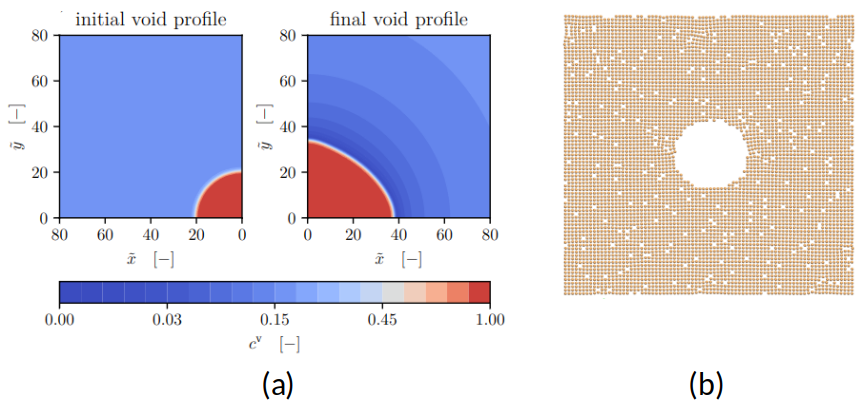Molecular Dynamics of Vacancy Diffusion and Derivation of Continuum-Scale Mechanical Descriptors

(b) Atomistische Darstellung der Anfangskonfiguration
Continuum models predict that vacancies in crystals drift along stress gradients toward regions of lower hydrostatic stress. This behavior governs, at the mesoscale, the phase-field description of void formation and growth; an existing phase-field model [1] already reproduces anisotropic void growth under tensile loading. The objective of this thesis is to reproduce this phenomenon on microscopic scales via atomistic simulations and to extract quantitative descriptors that specifically parameterize the phase-field model. Atomistic simulations (molecular dynamics, MD) track the motion of individual atoms using realistic interatomic potentials. Their strength is the ability to resolve atomic jumps between lattice sites that give rise to diffusion, quantify the associated activation barriers, and reveal the local coupling between defects and stress stress – without continuum-scale modeling assumptions.
Within the scope of the master’s thesis, MD simulations of vacancy diffusion under prescribed stress states are to be conducted using LAMMPS [2] and compared with established results from diffusion and phase-field models. The resulting atomistic data shall be used to derive continuum-level quantities and to identify indicators that can be fed as input parameters to mesoscale phase-field models (such as effective diffusivity/mobility).
[1] K. A. Pendl and T. Hochrainer. Coupling stress fields and vacancy diffusion in phase-field models of voids as pure vacancy phase. Comput. Mater. Sci., 224 (2023)
[2] A. P. Thompson et al. LAMMPS - a flexible simulation tool for particle-based materials modeling at the atomic, meso, and continuum scales. Comput. Phys. Commun., 271 (2022)
Tasks:
• Conduct a literature review on molecular dynamics and vacancy diffusion (under mechanical loading), as well as vacancy transport in continuum diffusion models
• Become familiar with LAMMPS (overview and simple test cases)
• Implement simulation and post-processing pipelines (setups with prescribed stress/strain; defect insertion; parameter study on the continuum sampling point; data evaluation)
• Validate algorithms, analyze and document results
What you should bring:
• Interest in solid mechanics and coupled multi-physics problems
• Programming experience (in any language) is an advantage
• Willingness to learn and work with existing software packages (LAMMPS)
What we offer:
• Close, hands-on supervision at the institute
• Training in numerical algorithms and the application of theoretical concepts
Start: available immediately
Contact: Dipl.-Ing. Dr.techn. Kevin Pendl BSc kevin.pendl@tugraz.at
Supervisors: Assoc.Prof. Dipl.-Ing. Dr.techn. Manfred Ulz & Dipl.-Ing. Dr.techn. Kevin Pendl BSc
